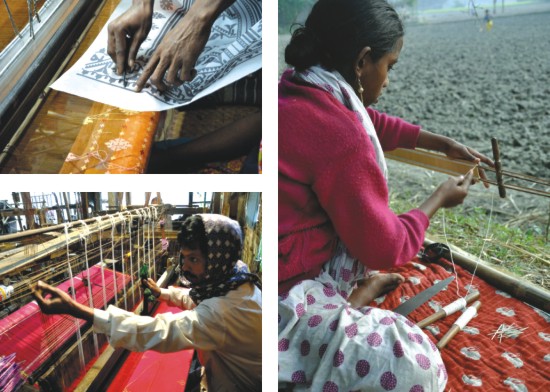Heritage
Unwinding the Lost Art
Tanzina Rahman
 Colourful threads, each making a divine statement on the piece of cloth that is being created on the pit loom by two weavers. It is a laborious process and in two months time, this carefully woven fabric- Jamdani, will fetch a good price. Colourful threads, each making a divine statement on the piece of cloth that is being created on the pit loom by two weavers. It is a laborious process and in two months time, this carefully woven fabric- Jamdani, will fetch a good price.
But do we understand the true value of these beautifully woven textiles?
According to Ismini Samanidou, a Textile Designer and Lecturer of Textile Design at University College Falmouth in Cornwall, UK, who has been on a residency programme organised by the British Council, little recognition is given to this very skilled work.
Samanidou has been visiting several entrepreneurs' shops that specialises in traditional crafts and designs of Bangladesh like Probartana, Aranya, Kumudini, Kay Kraft, Aarong and has also conducted workshops for the students at the College of Textile Engineering and Technology at Tejgaon, Dhaka. The objective of her residency is to build the capacity of the students and understand the creative economy around this sector.
"This residency programme is an opportunity to exchange ideas between two countries. We chose textile, since its one of the richer sectors of our country. In future we will be sending one of the designers from our country who will represent Bangladeshi textile designs and will also be visiting UK to become acquainted with their textile designs and share it when he comes back to the country," said Syed Masud Hossain, Head of Culture, Climate and Citizenship of British Council.
During Samanidou's visit, she has been to some of the textile and composite knitwear manufacturing factories, jute factories, traditional handloom weaving and natural dye places.
“I think there is a huge potential in the textile industry in Bangladesh. The unique combination of crafts, designs, textiles and opportunities are rare to find in other countries. In most cases the perceived value does not match the quality and craftsmanship for the work. I feel there is enormous possibility for Bangladesh to use its material resources and skilled artisans to develop a strong brand. We must establish a better working environment, sustainable practices and product development. There is a carefree lifestyle among the weavers because their work is not being valued enough in the society,” explained Samanidou on her visit to Tangail. She plans to learn about bamboo reed which is used by the local weavers of Tangail for their well known jacquard fabrics.

Her visit to Tangail serves another purpose though. Samanidou will be introducing the idea of these traditional textile techniques to the younger generation in the UK and highlight the value of these handmade products.
Many weavers living in the rural areas of Tangail use bamboo reeds to weave sarees. Unfortunately, these traditional aspects of weaving are losing its value as metal reeds are being introduced and also for the fact that little income comes from their work which is why people are finding alternative occupations as their source of income. It takes a whole day to make a hand woven cloth compare to metal reeds which takes less time to produce such fabrics. Without sufficient support from organisations and the government there is a possibility that soon these skilled works will be nothing but lost arts of our country.
Unlike Bangladesh, UK has a supporting body to look after the craft and design sector. The British Craft Council provides adequate funds to promote the skills of local artisans. Samanidou has said that in Bangladesh things are managed differently, separate bodies are running the local designs and artefacts.
“I still think there are good prospects for design in Bangladesh, but changes need to be made for this to happen. Production facilities need to work, materials need to be available, technical skills need to be enhanced, experimentation needs to be encouraged. I don't know what the solution can be, and all I can do is raise the issue, inspire conversations and foster ideas,” Samanidou added.
Developing the Textile Industry in Bangladesh should be one of the major concerns of the government. On one side we have expertise in the handloom and traditional designs, and on the other we have established strong export bonds. The only missing link in this is that we do not have proper training to nurture the local artisans in Bangladesh. Today neighbouring countries like Malaysia and Singapore are taking their resources such as tourism and highlighting it immensely. Not only is it working towards the country's benefit but also ultimately it is becoming the trademark of the country. Perhaps if local designs are nurtured, textile will one day be our trademark.
Copyright
(R) thedailystar.net 2009 |
